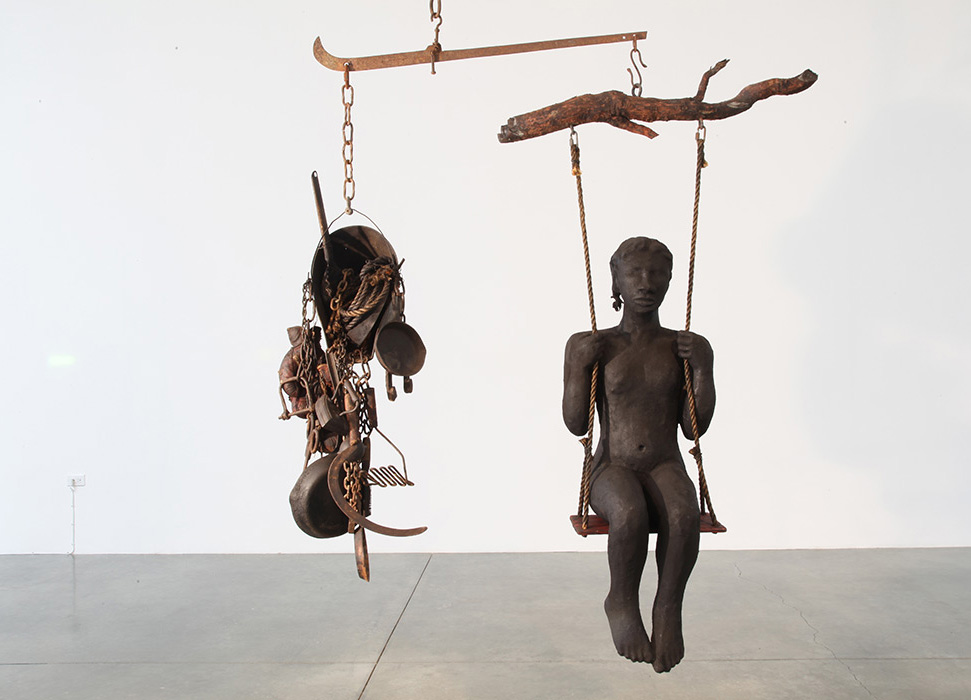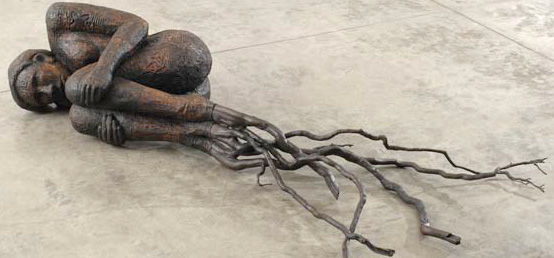
Until January 15 in Watts Towers Art Center, Watts, CA.
Tippy Toes, 2007.
About:
 Strange Fruit.
Strange Fruit.
Hanging in the corner of the Baltimore Museum of Art (BMA) Contemporary Wing’s Figuration Room is a nude female figure. The sculpture, titled Strange Fruit, is bound at the ankles and dangles precariously from a ceiling beam. In stark contrast to the minimalist white room, the violent portrayal of this dark figure demands one’s full attention. Visitors can be found circling the piece, questioning Alison Saar and the message conveyed by her disturbing work of art.
Seemingly destined for a creative life, sculptor Alison Saar was engrossed in fine art starting in her early childhood. Born to an art conservator father and artist mother, Saar grew up frequenting museums, reading art books and watching its formation firsthand. As a teenager, Saar aided her father’s various restoration efforts and realized the importance of durable mixed mediums. Saar later mastered in both African and fine art while attending university.
 Weight, 2012.
Weight, 2012.
The Los Angeles, Calif. native focuses her energy on a diverse range of African, Caribbean and Latin American cultural themes. The Baltimore Museum of Art is fortunate enough to display her intriguing commentary on America’s treatment of blacks –particularly black women — in the form of Strange Fruit.
The piece’s title overtly alludes to the 1939 Billie Holiday song (also named “Strange Fruit”) in which Holiday describes mob lynching. The lyrics read: “Southern trees bear a strange fruit, blood on the leaves and blood on the root. Black bodies swinging in the southern breeze; strange fruit hanging from the poplar trees.” As the fixation on restoring white supremacy increased after the Civil War, so too did acts of lynching — most commonly beset against black men.
 Cotton Eater.
Cotton Eater.
Yet, Saar focuses not on the male victim, but rather on the far less frequently targeted African American woman. Like many of Saar’s human sculptures, Strange Fruit was designed with ample breasts and curves. The nearly featureless face is adorned with red lipstick, signifying a female distinction. The subtle leaf detailing along the stomach symbolizes the life attached to her navel. Central to the figure’s female identity is the familiar body positioning, for identical hand placement is depicted in Botticelli’s 1485 The Birth of Venus.
Venus — often hailed as a symbol of modesty — has been literally turned upside-down in Strange Fruit. Lost is Venus’ unblemished grace and purity, and in their place is a being charred and broken. In lieu of skin, Saar attached tin alloy scraps to symbolize the potential of disregarded entities to collectively join and create something not only strong, but also poignant.
 Fall, 2010.
Fall, 2010.
Most intriguing is the keyhole at the center of Strange Fruit. The missing key insinuates that buried inside this dark, intimidating and clearly violated figure is something of value and worthy of protection.
By AUBREY ALMANZA
Published: January 30th, 2014
 Lost and Found, 2003.
Lost and Found, 2003.

